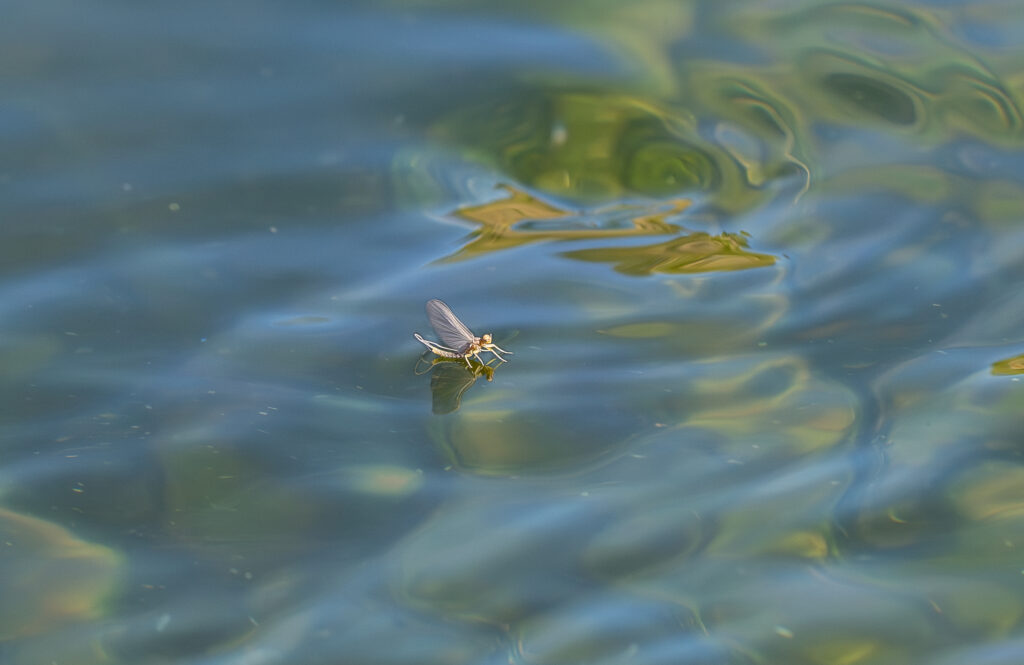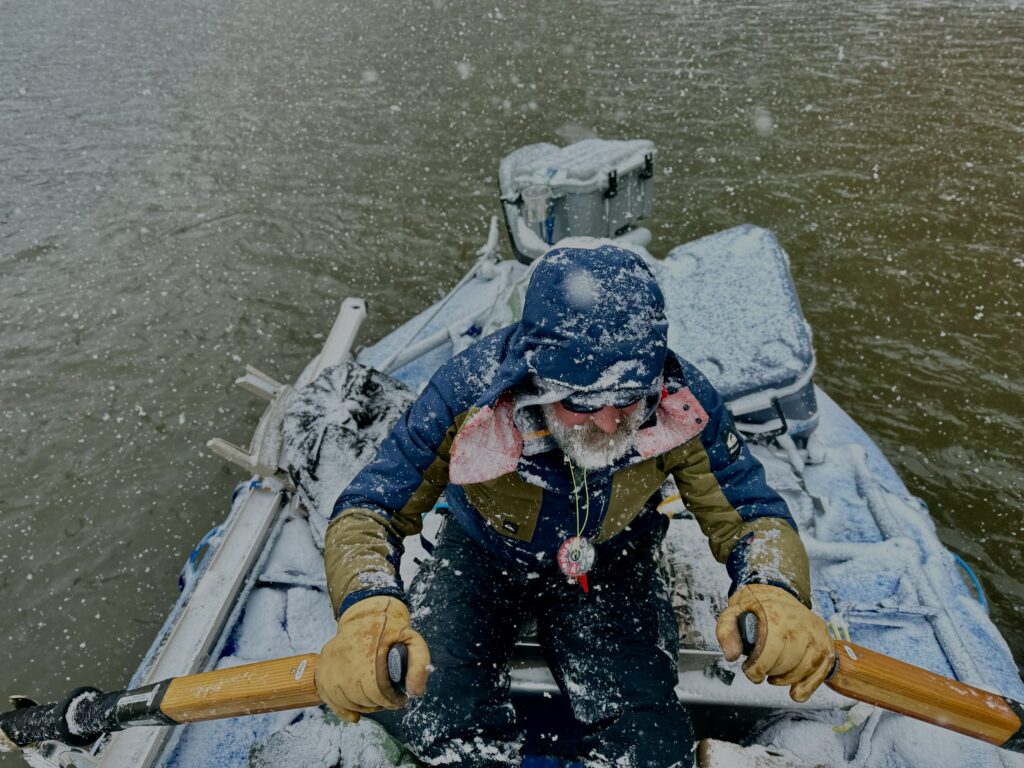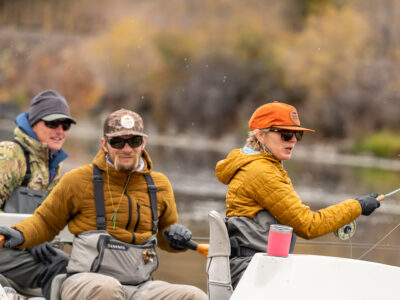Spring on the Missouri, particularly the section below Holter Dam, is a time of transition. The river’s famed blue-ribbon section from Wolf Creek to Cascade comes to life, and the opportunity for exceptional fishing begins. The bitter cold days of winter give way to an energized fishery as water temperatures begin to rise. Brown and rainbow trout that have spent the past months conserving energy begin to move into feeding lanes, eager to replenish lost reserves. While April can still bring snow and cold, May offers more consistent conditions.
Spring Outflows From Holter Dam
The Missouri, is a tailwater fishery controlled by a series dams. The dams helps maintains stable flows compared to our freestone rivers, making it a dependable early-season fishery. However, outflows can increase due to runoff as we get into late May and early June. It’s important to note that the tributaries like the Prickly pear and Dearborn river can begin to put some color in the river. Keeping an eye on flow reports can help anglers plan accordingly.
Early Season Hatches on the Missouri
Spring hatches are temperature driven. When water temperatures climb into the mid 40s and 50s, insect activity increases, and the trout respond accordingly.
- Midges: These tiny insects hatch throughout the winter but become even more prolific in early spring. Dry fly anglers can find fish sipping midges in back eddies and soft seams, while nymph fishermen should always have a few zebra midges in their boxes.
- Baetis (Blue-Winged Olives): When water temperatures break the mid 40s the Missouri’s famous Baetis hatches begin. These small mayflies, often in size 16-20, bring pods of hungry trout to the surface. A well-presented BWO dry fly, such as a Parachute Adams or 401K Baetis, can lead to some fantastic fly fishing.
- March Browns: Though not as prolific as Baetis, March Browns make an occasional appearance. These larger mayflies (size 12-14) are eagerly taken by opportunistic trout.
Nymphing: A staple of Spring Fishing on the Missouri River
While dry fly purists maybe head hunting and hold out for rising fish, nymphing remains the most consistent approach during early spring.
- Sow Bugs and Scuds: The Missouri is known for its abundant sow bugs and scuds. These small crustaceans are a year-round food source, and spring is no exception. Sizes 14-18 in grey, pink, and rainbow work well.
- Baetis and Midge Patterns: Thin pheasant tails, RS2s, JuJu baetis and small zebra midges can be highly effective. A two-fly rig with a sow bug trailed by a Baetis nymph can be a deadly combination.
- San Juan Worms: With spring runoff and increased flows, worms become a prime food source. A pink or red San Juan Worm, especially after a bump in flow, often gets fish to eat.
- Depth and Weight Matter: Adjusting depth and weight is critical in early spring. Fish are not always in deep winter holes, but they also aren’t as spread out as in summer. Pay attention to water speed, and adjust your indicator or split shot accordingly.

Streamer Fishing: The Time for Big Browns
For those looking to target Missouri River brown trout, spring presents a great opportunity. As water temperatures rise in the 50’s, aggressive fish start to chase baitfish, sculpins, and leeches.
- Best Conditions for Streamers: Cloudy days, rising flows, and off-color water often bring out the best streamer action. Early mornings and late evenings can also be prime times.
- Fly Selection: Classic patterns like the Sparkle Minnow, Kreelex, and Thin Mint are all productive. Black, olive, and white are good color choices.
- Retrieve and Presentation: A mix of dead drifts, slow strips, and erratic jerks can trigger eats. Experiment with different retrieves and depths until you find what works.
Spring Dry Fly Fishing
When conditions align, spring dry fly fishing on the Missouri can be spectacular. Finding pods of trout sipping midges or Baetis in slow back eddies or bubble lines is common, particularly on calm, overcast days. However, presentation is everything. The Missouri’s trout are notoriously cautious, so fishing a long leader, light tippet (4x-5x), and a drag-free drift is essential.
A few tips for success:
- Observe Before Casting: Slow down , watch the feeding patterns and rise form. Are fish taking emergers just under the surface, or are they eating spinners off the top?
- Make the First Cast Count: Read the currents, take a few practice cast away from the fish. These fish see a lot of flies and won’t tolerate a poor presentation.
- Positioning Matters: Approach cautiously and position yourself or the boat above the fish for a downstream presentation.
Spring Weather and River Conditions
Spring Fishing on the Missouri River can unpredictable. One day can be sunny and 50 degrees, the next can bring snow and wind. Being prepared with proper layering, rain gear, and gloves can make all the difference. Winds are a near-constant factor on the Missouri, particularly in the spring. Learning to cast in the wind and mend effectively will put more fish in the net.

Conservation and Etiquette
Spring is a sensitive time for trout, as they emerge from winter and prepare for spawning (particularly rainbows). Practicing good catch-and-release techniques, minimizing handling time, and keeping fish wet ensures a healthy fishery.
River etiquette is also important, particularly as the season picks up. Giving space to other anglers and being respectful of both wade and boat anglers go a long way in maintaining a positive experience for everyone.
Final Thoughts on Spring Fishing
Spring fishing on the Missouri River is a time of excitement, challenge, and reward. Whether you’re nymphing deep runs, stripping streamers for big browns, or waiting for that perfect dry fly moment, the Missouri in spring offers something for anglers of all skill levels.


 Fishing Below Hauser Dam: Exploring the Land of the Giants
Fishing Below Hauser Dam: Exploring the Land of the Giants 
I am looking for advice regarding a trip to the Missouri river May 18-23, 2025. I have never fished the Missouri. I would be looking for a float trip or two and a wading day.
Russell Give us a call at 406-465-1688. Happy to help answer and questions you may have.